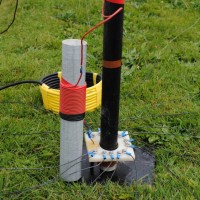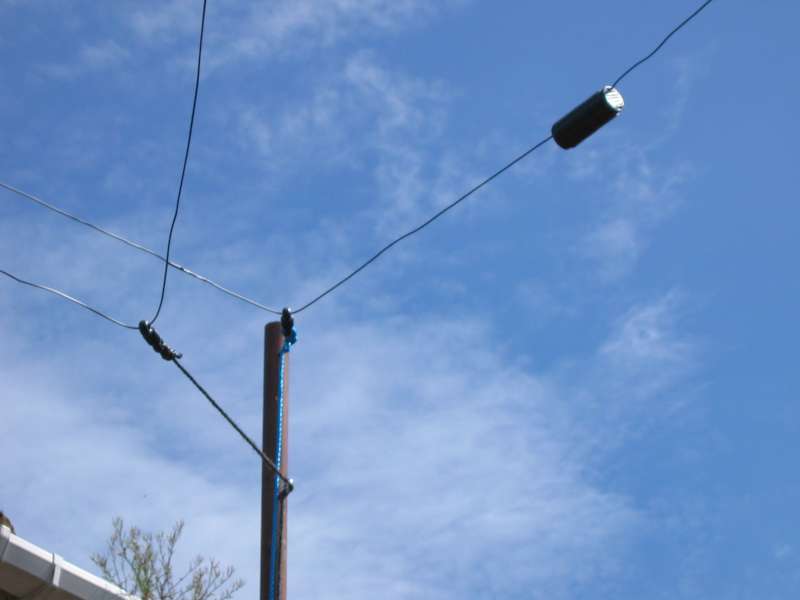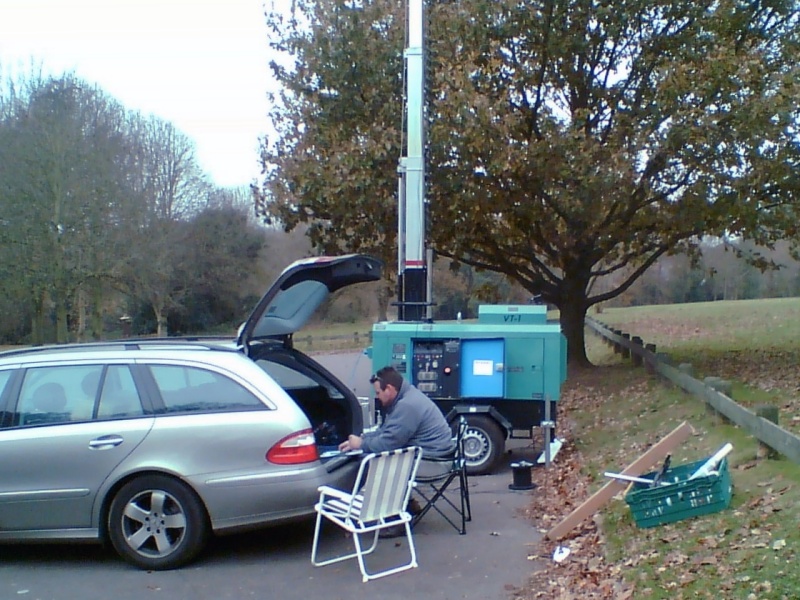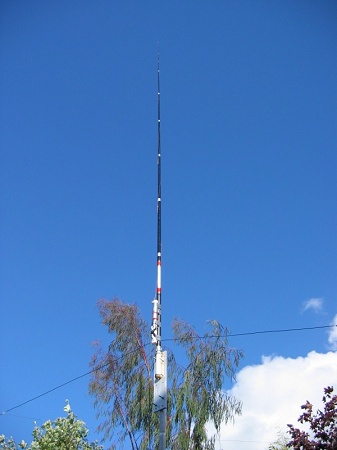Recently, I created a slightly loaded 40m vertical with 25 ground radials. It seems to work very well although the receive noise is pretty lousy compared to my loops and dipoles, however on transmit, it does seem to work as planned; a typical 1/4 wave pattern that outperforms regular dipoles at low angles of radiation. Continue reading
Tag Archives: 80m
Adding a loading coil to a 40m Vertical for 80m operation
 A successful morning today to convert my 40m vertical to an 80m vertical by adding a loading coil that I can switch out manually by just unplugging it. Nice and simple.
A successful morning today to convert my 40m vertical to an 80m vertical by adding a loading coil that I can switch out manually by just unplugging it. Nice and simple.
It’s not a great SWR curve due to the loading coil but I achieved 1.8:1 SWR at 3.79 Mhz, ideal for DX.
For the techies who want the dimensions: I wound 24 and a half turns on a fibreglass 2 and a quarter inch fibreglass former. The length of the coil itself is 3.5 inches.
How to make a loop antenna for 40m and 80m bands
 I’ve been an addict of full wave (and partial wave) loops since realising many years ago that in comparison to a dipole, you get more bang for your buck if you build a loop – certainly you get more copper in the air – and loops are resonant on EVERY harmonic so a 40m loop will be resonant on 20, 15m and 10m. A multi-band antenna for peanuts. They will receive better too, so for a housing estate, these are mandatory.
I’ve been an addict of full wave (and partial wave) loops since realising many years ago that in comparison to a dipole, you get more bang for your buck if you build a loop – certainly you get more copper in the air – and loops are resonant on EVERY harmonic so a 40m loop will be resonant on 20, 15m and 10m. A multi-band antenna for peanuts. They will receive better too, so for a housing estate, these are mandatory.
When I first started out with this hobby, I had a half-sized G5RV and I genuinely thought that I’d never get onto the 80 meter band. Within 18 months, I had worked out that you can build a loop of a wavelength in circumference (give or take a percent or so) and feed it directly with coax (and a 4:1 balun). Even better was the idea of putting loading coils in each corner of a square loop and you could lower the resonant frequency by a substantial amount.
Footnote: 40m and 80m skyloops for your back garden
You may have a smallish back garden like me; 10m deep and 14m wide. Your 40m loop (that’s really 40m [or so] all the way around) will resonate on the 40, 20, 15 and 10m bands. Mine is only about 20 feet off the ground, around gutter height. Its not quite square but the far side and the near side are completely different lengths to make it nearly a triangle. Not quite. I have coax to the feedpoint and a cheap 4:1 balun there. With some trimming on a sunny day, you can make it work on all the amateuir bands – and I even used it on 2m once!
My 80m loop was (and still is) square at about 15m per side which is actually too small for the 80m band. My 80m loop is actually 60m all the way around. To make it “bigger”, I added 4 x loading coils into each corner. These coils are 2 inch in diameter, 6 inches long and approximately 30 turns on each coil. With some farting about, you can easily make it tune either the CW or the SSB portion of the band. If you have a tuner, you’ll dial that out easily anyway, particularly at lower power: 400 watts and under. The 80m loop happens to work on 30m band too. Just a fluke. Great for digital.
M0XXT/P HF Doublet Test
 James and I tested out a doublet today in preparation of our trip to Hampton in Arden Cubs, Friday 30th November.
James and I tested out a doublet today in preparation of our trip to Hampton in Arden Cubs, Friday 30th November.
We used the generator to power the FT1000MP MkV (200w) effortlessly pumping the hydraulic mast up to 10m with the SG230 bungee-strapped to the top, running one of our 80m dipoles across the top to form a doublet.
Total set up time was about 25 minutes. This included un-hiching the generator and levelling the mast.
We called CQ on 3.750.00 from the boot (see picture) and G3ZSE (John) came straight back with a 59 report. Then the rain started! We had parked the car so that the wind was off us but even so, it didn’t take very long for everything to get wet!
We only spent 30 minutes on the radio and had a pleasant 6-station pile-up but after clearing with G4FWG , we tore down the gear as fast as possible. I could hardly feel my fingers and my gut feeling was that shortly it would be hammering down. Within 25 minutes though, we were back at home for a cup of tea, all packed up.
In the log today:
- G3ZSE (John in Kettering)
- G4MSF/M (Keith, 10W in Gateshead)
- M1HDD (Dave in Chesterfield)
- GW4ZPL (John in North Wales)
- 2E0RWX (Ron in Humberbridge)
- G4FWG (Malcolm in East Sussex)
Bottom line: For 80m NVIS style of operation, it works a treat.
80m vertical -vs- 80m horizontal loop
Vertical vs Horizontal:
Overview: The first thing that I noticed was that during daylight hours, the vertical was utterly hopeless. Inter-G signals were virtually unreadable, to the point I thought it wasn’t working. Indeed, being daylight, I couldn’t hear a thing, just noise. Switching my NVIS loop in to circuit brought the band to life with usual weird discussions of carrot growth and weather. As nightfall fell, the vertical started performing but nowhere near the performance of the loop. By 22:00 UTC, the Russian and nearby European stations started coming in stronger, but again sounded better on the loop and it didn’t seem to matter what antenna I used to transmit on either. One German noted on comparison tests absolutely no difference on TX.

I called for RP3PRP on the loop (he was loud) and he had some problems receiving me so I switched to the vertical and we exchanged reports and my confidence rose. Again with 9A7KM, I started the exchange with the loop because that’s where he sounded so good but flipped to the vertical to complete. Confidence grew higher. Then UP0L in Khasakstan for a 3,500 mile hop again on the vertical. But this isn’t the whole story. Don’t think the vertical performed better on TX than the loop everytime – this isn’t the case. This particular vertical is one heck of a compromise; remember, only about one ninth wavelength and only three meters above the ground.
My loop on the other hand is a proven high performance antenna that’s got a history of DX to the Far East and North and South America. After a couple of hours and 48 QSOs across 20 countries, I realised that for 90% of the QSOs that you make on 80m, an inverted V, a regular dipole or perhaps a delta loop (like mine) at around 30 feet will be fabulous – and you’ll have the advantage of being able to have a QSO in your own country. Occasionally, having the flexibility of switching the vertical in gives you an added interest but it’s hardly worth the effort. A 4-square would be a different story though, and for the uninitiated: a 4-square is 4 x ¼ wave antennas phased in a square, quarter wavelength apart that ‘pushes’ a lobe of RF (db gain) in a specific direction at the push of a button. However it’s hardly an event antennal, more suited to permanent installs.
For me though, I don’t think this test was completely conclusive. I’d like to build a full-size quarter wave with full-sized raised radial set to complete the test with a feedpoint at 5 or 6 meters above ground: in other words, doubling the size of this little twig and maybe I can aim at building it for this year’s NFD. I have a feeling that it was the loaded radials that was restricting my efficiency, not the loading coil in the driven element. My experience of a 40 meter quarter wave gives me some confidence in this arena but I’m also wary of the different characteristics of 80 meters which maybe much more suited to higher dipoles.
There was though one small advantage that I haven’t documented, and that’s the use of a vertical as a dedicated QRM receive antenna. I scored many points by finding distance stations between strong UK stations. I can reduce UK stations by around 40 db by switching in the vertical, whilst at the same time keeping the target station clear in my headphones.
In conclusion, verticals for 20 meters and above may well be good performers and I’ll certainly have a bash at a 20 meter version of this shortly but for 40 meters and below, be clear about what they’ll do for you. I do not recommend them as your primary antenna unless of course you are very restricted on space – and even then, there are shortened alternatives that can be squeezed into small plots.
Dedicated 80m Vertical

I didn’t document fully last weekend that my 40m vertical experiment gave me a rather good match on 3.8Mhz. This gave me the idea of building a better 80m vertical this weekend by loading up both the vertical – and the radials. As I type this as I discover that first time up, I’ve achieved a resonance (of sorts) at 3.456 Mhz however, I’m not getting 50 ohms. The SWR is at best just under 2:1. I have reduced the legs of the radials a bit because of the loading coils (which all have 68 turns on my favourite 40mm plumbers pipe). I shall now adjust only the vertical coil. I know I should in theory adjust all the coils to keep them in unison however, the actual length of the radials is not precisely known; only that they are ‘about’ 9 meters plus a loading coil – and in any case I can just shorten the radials for fine tuning.
Here’s the resonant coil adjustment chart for the vertical coil:
- 68 turns: 3.456 Mhz
- 67 turns: 3.470 Mhz
- 63 turns: 3.535 Mhz
- 59 turns: 3.600 Mhz
- 55 turns: 3.690 Mhz (1:1 SWR dead)
- 54 turns: 3.691 Mhz (I tightened up the radials which had an adverse effect so that the resonant frequency hardly moved)
- 52 turns: 3.740 Mhz (SWR rising a whisker now)
I finished on 53 turns in the end. I’ve started keeping a couple of turns or more spare, never cutting off all the ‘dead ones’ as I take them off so I can wind them back on if I overshoot. My ‘best’ spot frequency is now 3.715 at 1:1 SWR with a 2:1 SWR curve starting at 3.6 and going all the way beyond 3.8. In fact, 3.8 has an SWR less than 1.5:1.